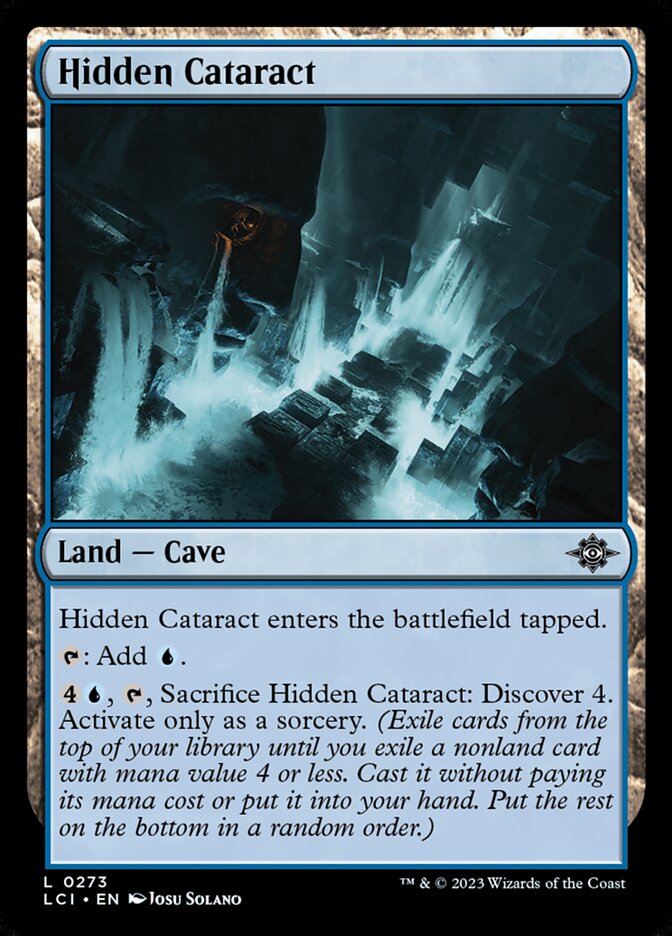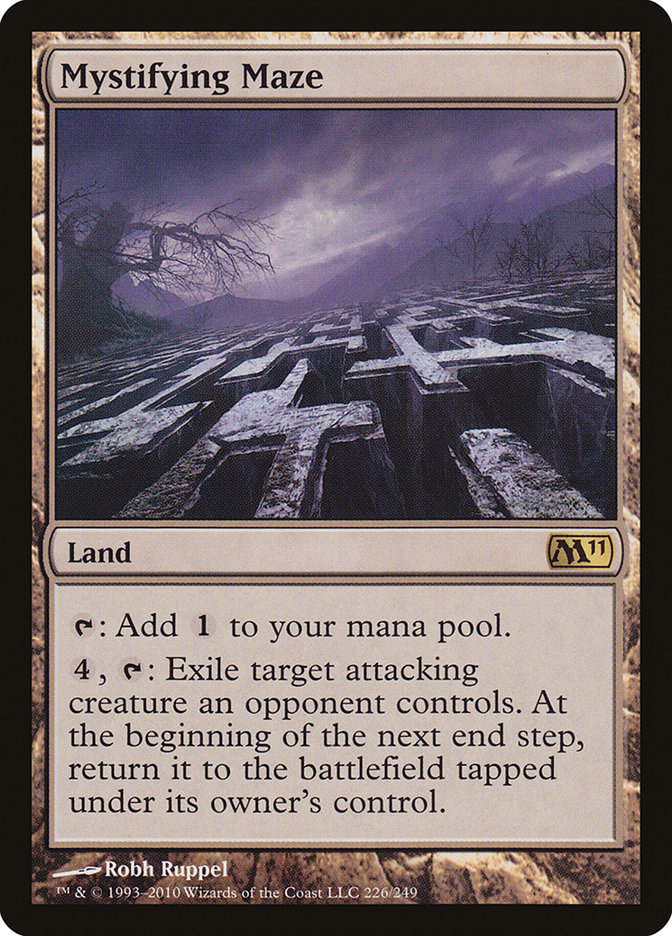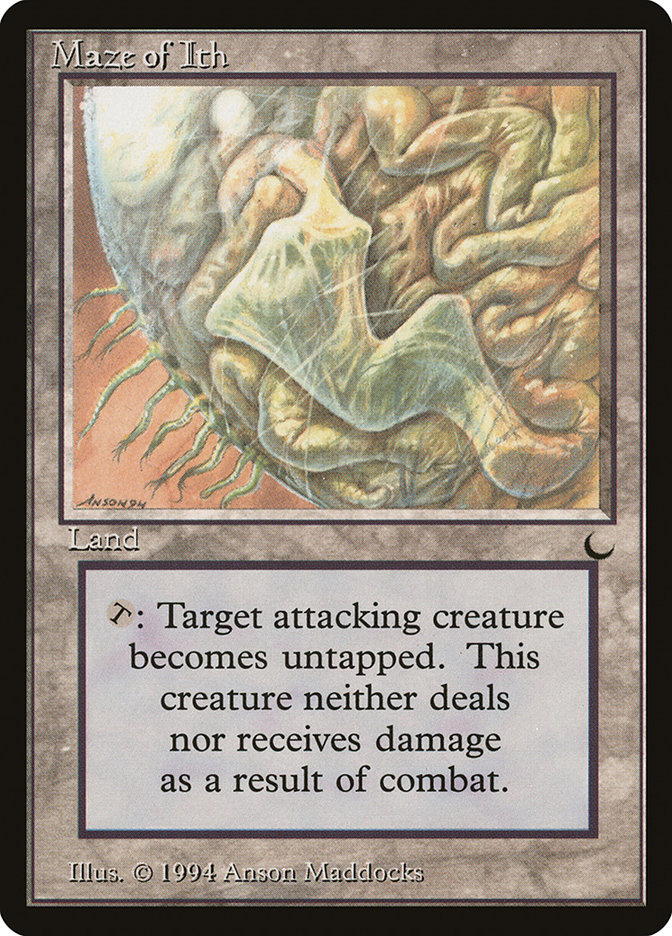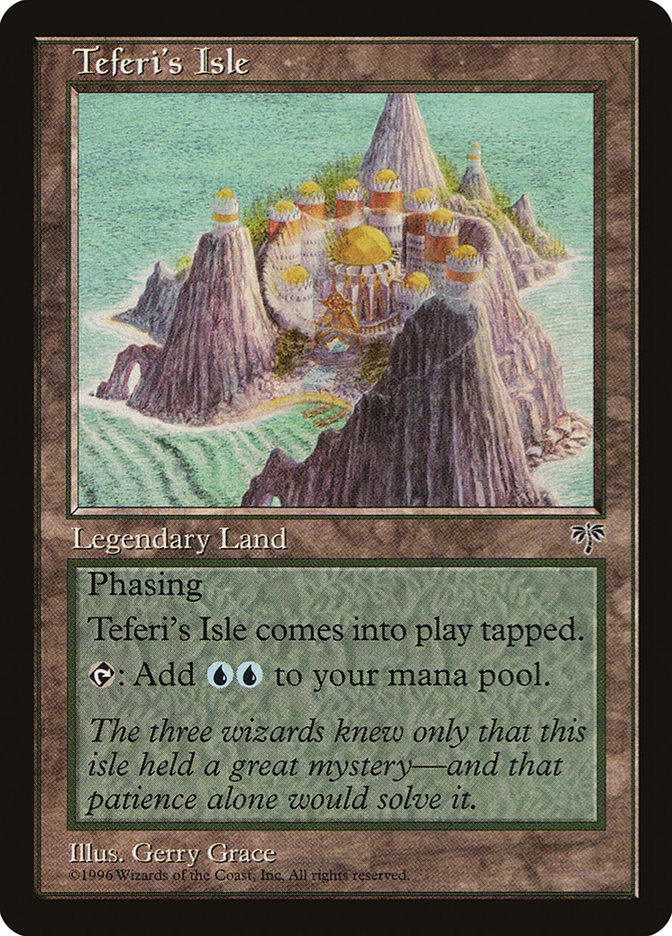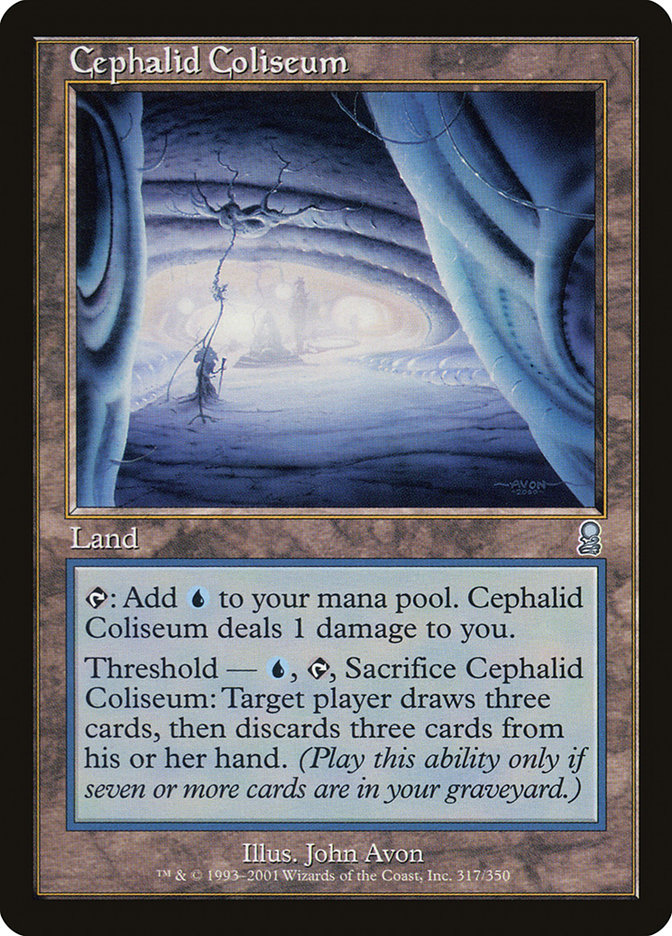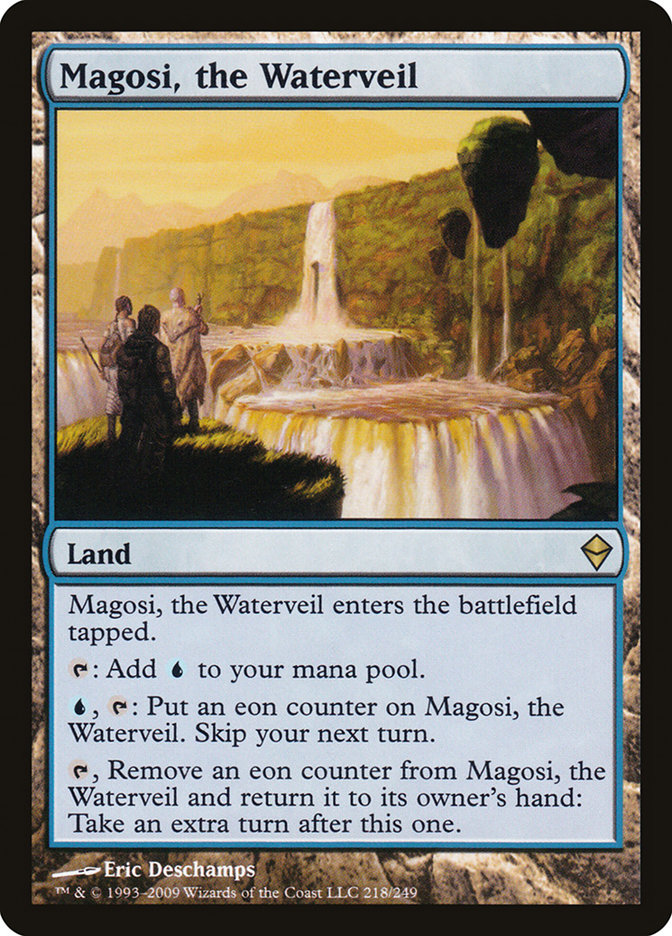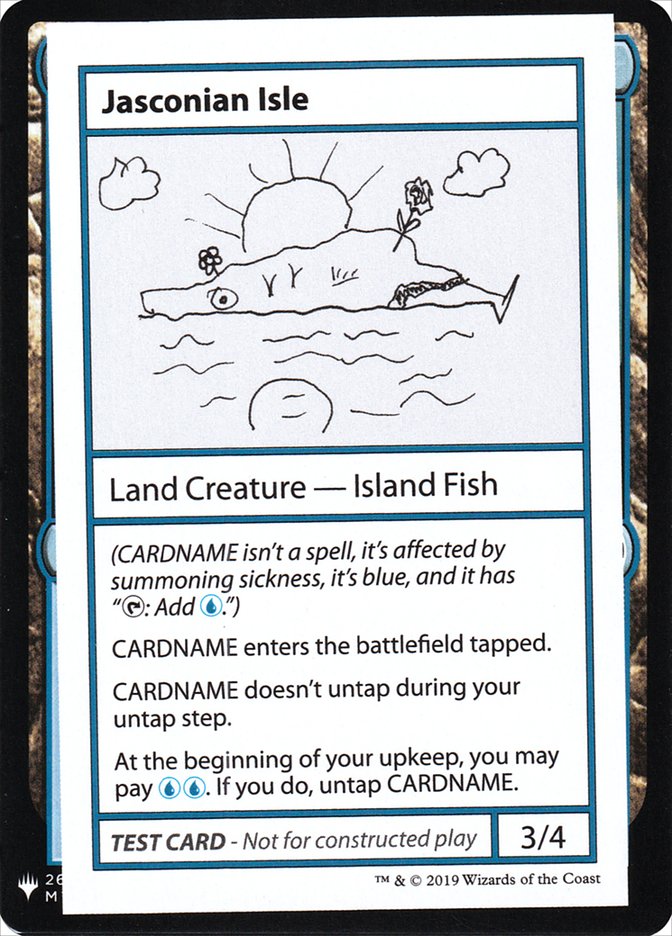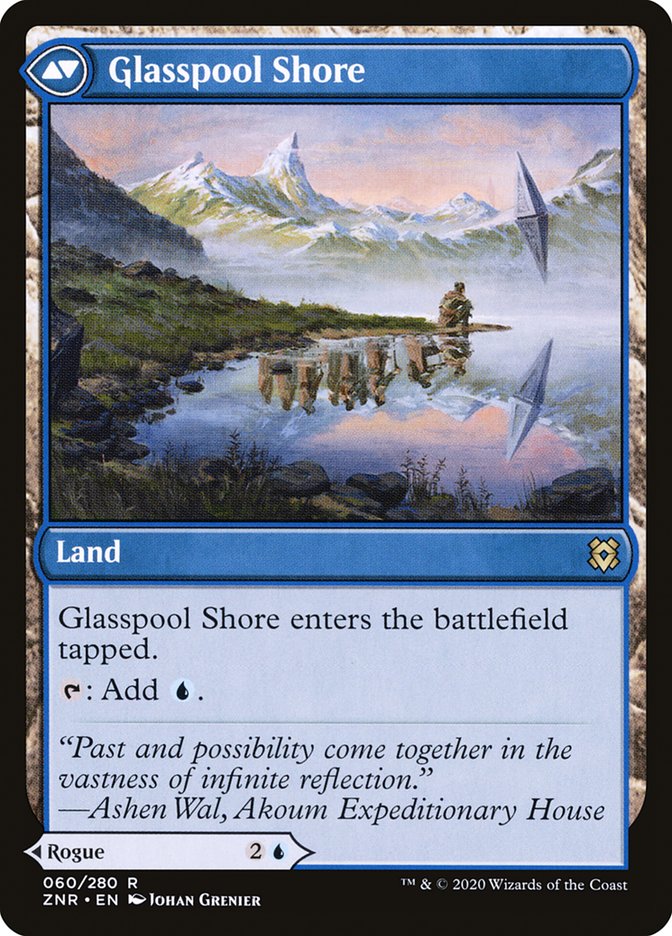Hidden Cataract MTG Card
| Card sets | Released in 2 setsSee all |
| Rarity | Common |
| Type | Land — Cave |
| Abilities | Discover |
Text of card
Hidden Cataract enters the battlefield tapped. : Add . , , Sacrifice Hidden Cataract: Discover 4. Activate only as a sorcery. (Exile cards from the top of your library until you exile a nonland card with mana value 4 or less. Cast it without paying its mana cost or put it into your hand. Put the rest on the bottom in a random order.)
Cards like Hidden Cataract
Hidden Cataract joins the vast repertoire of lands within Magic: The Gathering, offering unique mechanisms to give players a strategic edge. Much like its counterpart, the well-known Mystifying Maze, Hidden Cataract allows players to temporarily remove attacking creatures from combat. While Mystifying Maze provides this effect outright for four mana and a tap, Hidden Cataract, however, requires a converted mana cost of three or less from the player’s hand to activate its ability.
Another parallel can be drawn with Maze of Ith. This legendary land offers a similar functionality as it untaps attacking creatures and prevents all combat damage that would be dealt to and dealt by that creature. It does not require any mana to be activated, making it a free option albeit it doesn’t give mana itself. However, unlike Hidden Cataract, Maze of Ith doesn’t have the added bonus of being a source of mana when not used for its creature-neutralizing ability. In addition, it doesn’t require the player to reveal a card from their hand.
Assessing these comparisons, Hidden Cataract serves a dual purpose: enabling a tactical defense against attackers and being an admittedly conditional but potential mana source. This grants MTG deck builders an intriguing option when considering utility lands for their construction.
Cards similar to Hidden Cataract by color, type and mana cost
Card Pros
Card Advantage: Hidden Cataract ensures a steady flow of options by allowing you to sift through your deck, putting a land card into your hand. This ability fortifies your position, ensuring that you don’t miss land drops and thus keeping you well-stocked with resources throughout the duel.
Resource Acceleration: By fetching a specific land card, Hidden Cataract can facilitate color fixing, smoothing out mana issues, which in turn can lead to resource acceleration. This supports casting high-impact spells sooner, effectively speeding up your game plan.
Instant Speed: The ability to play Hidden Cataract at instant speed offers strategic flexibility, permitting you to adapt to the evolving game state. This can provide a significant edge, letting you react to your opponent’s moves or optimize your turns for a surprise shift in the battlefield dynamics.
Card Cons
Discard Requirement: When playing Hidden Cataract, you may find yourself in a position where the requirement to discard a card can be a serious downside. This cost often means sacrificing crucial hand advantage, which can be particularly painful in the late game or when your hand is already depleted.
Specific Mana Cost: Hidden Cataract demands a dedicated mana base to meet its specific coloration needs. This can make it a challenging fit in multicolored decks and potentially a dead draw if your lands aren’t aligned with its casting cost.
Comparatively High Mana Cost: With its higher casting cost, Hidden Cataract may not always be the most mana-efficient play. For decks that aim to curve out or maintain tempo, the investment in both mana and cards can set a player back when other options for generating card advantage or developing the board might be available at a lower cost.
Reasons to Include Hidden Cataract in Your Collection
Versatility: Hidden Cataract is a highly adaptable land card that seamlessly fits into a variety of deck builds. Its ability to provide colorless mana without entering the battlefield tapped makes it a solid choice for decks that need a reliable mana base without the tempo loss.
Combo Potential: In decks that manipulate or benefit from land types, Hidden Cataract offers a unique opportunity to act as a catalyst. Its presence can synergize with landfall abilities or support strategies that revolve around land type counts.
Meta-Relevance: With the shifting landscapes of Magic play, Hidden Cataract maintains its relevance. Its straightforward utility can become a linchpin in matches that hinge on consistent land drops and where versatility in mana sources can tip the scales in your favor.
How to beat
Hidden Cataract may seem unassuming in the world of Magic: The Gathering, but it packs a strategic punch. With its land cycling ability, it ensures that you not only get a land drop but also thin the deck to improve card quality on subsequent draws. Players often compare its deck-thinning ability to that of a fetch land, albeit without the option to search for dual lands.
Confronting a strategy that includes Hidden Cataract requires a keen understanding of your opponent’s mana base and the importance of land drops. To counter its benefits, employing land disruption strategies such as land destruction or graveyard interference can be effective. Cards like Ghost Quarter can remove key lands from play, while Rest in Peace can neutralize strategies relying on cycling and graveyard synergies.
In essence, while Hidden Cataract provides an adaptable tool for players to fine-tune their mana and deck performance, it’s not unbeatable. A deck well-equipped with land disruption and graveyard hate cards can level the playing field, ensuring that the advantage Hidden Cataract gives is minimized or even turned into a liability.
Where to buy
If you're looking to purchase Hidden Cataract MTG card by a specific set like The Lost Caverns of Ixalan and Modern Horizons 3 Commander, there are several reliable options to consider. One of the primary sources is your local game store, where you can often find booster packs, individual cards, and preconstructed decks from current and some past sets. They often offer the added benefit of a community where you can trade with other players.
For a broader inventory, particularly of older sets, online marketplaces like TCGPlayer, Card Kingdom and Card Market offer extensive selections and allow you to search for cards from specific sets. Larger e-commerce platforms like eBay and Amazon also have listings from various sellers, which can be a good place to look for sealed product and rare finds.
Additionally, Magic’s official site often has a store locator and retailer lists for finding Wizards of the Coast licensed products. Remember to check for authenticity and the condition of the cards when purchasing, especially from individual sellers on larger marketplaces.
Below is a list of some store websites where you can buy the Hidden Cataract and other MTG cards:
 BUY NOW
BUY NOW BurnMana is an official partner of TCGPlayer
- eBay
- Card Kingdom
- Card Market
- Star City Games
- CoolStuffInc
- MTG Mint Card
- Hareruya
- Troll and Toad
- ABU Games
- Card Hoarder Magic Online
- MTGO Traders Magic Online
See MTG Products
Printings
The Hidden Cataract Magic the Gathering card was released in 2 different sets between 2023-11-17 and 2024-06-14. Illustrated by Josu Solano.
| # | Released | Name | Code | Symbol | Number | Frame | Layout | Border | Artist |
|---|---|---|---|---|---|---|---|---|---|
| 1 | 2023-11-17 | The Lost Caverns of Ixalan | LCI | 273 | 2015 | Normal | Black | Josu Solano | |
| 2 | 2024-06-14 | Modern Horizons 3 Commander | M3C | 348 | 2015 | Normal | Black | Josu Solano |
Legalities
Magic the Gathering formats where Hidden Cataract has restrictions
| Format | Legality |
|---|---|
| Standard | Legal |
| Historicbrawl | Legal |
| Historic | Legal |
| Legacy | Legal |
| Paupercommander | Legal |
| Oathbreaker | Legal |
| Gladiator | Legal |
| Alchemy | Legal |
| Pioneer | Legal |
| Commander | Legal |
| Modern | Legal |
| Pauper | Legal |
| Future | Legal |
| Vintage | Legal |
| Duel | Legal |
| Explorer | Legal |
| Brawl | Legal |
| Penny | Legal |
| Timeless | Legal |
Rules and information
The reference guide for Magic: The Gathering Hidden Cataract card rulings provides official rulings, any errata issued, as well as a record of all the functional modifications that have occurred.
| Date | Text |
|---|---|
| 2023-11-10 | "Discover N" means "Exile cards from the top of your library until you exile a nonland card with mana value N or less. That card is the "discovered" card. You may cast that card without paying its mana cost if the resulting spell's mana value is less than or equal to N. If you don't cast it, put that card into your hand. Put the remaining exiled cards on the bottom of your library in a random order." |
| 2023-11-10 | A spell's mana value is determined only by its mana cost. Ignore any alternative costs, additional costs, cost increases, or cost reductions. |
| 2023-11-10 | If the discovered card has in its mana cost, you must choose 0 as the value of X when casting it without paying its mana cost. |
| 2023-11-10 | If you can't cast the discovered card (perhaps because there are no legal targets for the spell), you'll put it into your hand. |
| 2023-11-10 | If you cast a spell "without paying its mana cost", you can't choose to cast it for any alternative costs. You can, however, pay additional costs. If the spell has any mandatory additional costs, you must pay those to cast it. |
| 2023-11-10 | If you discover an adventurer card, split card, or modal double-faced card, you might be able to cast that card with either set of characteristics depending on the effect's discover value. For example, if you discover 4 and reveal Galvanic Giant (an adventurer card from Wilds of Eldraine with a mana value of 4), you could cast Galvanic Giant, but not Storm Reading (its Adventure, which has a mana value of 7). If you discover 7 and reveal Galvanic Giant, you could cast either Galvanic Giant or Storm Reading. |
| 2023-11-10 | Some spells and abilities that cause you to discover may require targets. If each target chosen is an illegal target as that spell or ability tries to resolve, it won't resolve and you won't discover. |
| 2023-11-10 | The mana value of a split card is determined by the combined mana cost of its two halves. If discover allows you to cast a split card, you may cast either half (as long as its mana value is less than or equal to the effect's discover value) but not both halves. |
| 2023-11-10 | When you discover, you must exile cards. The only optional part of the ability is whether you cast the exiled card or put it into your hand. |
| 2023-11-10 | You exile the cards face up. All players will be able to see them. |
